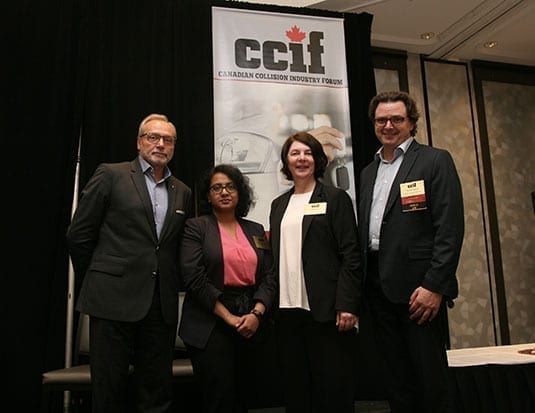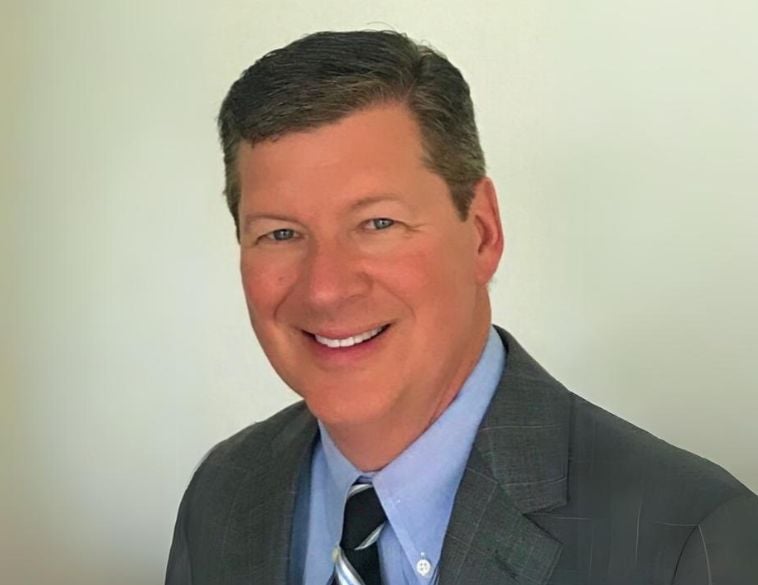Professionals from across the entire collision repair industry in Canada (and from the U.S. as well) gathered at the Radisson Hotel, Vancouver Airport in Richmond, B.C. on September 28, for the third of this year’s CCIF events.
With 20 percent new attendees this time out and a record 347 registrations, CCIF Vancouver also represented the first test event for the new CCIF app, which will be rolled out in full force in Toronto next year.
20th anniversary coming
Additionally, Toronto will mark CCIF’s 20th anniversary, with a special gala ceremony to follow the actual forum.
Getting back to the present, the Vancouver event had plenty on offer in terms of content and ideas.
CCIF Chairman Patrice Marcil provided an update on the Collision Education Industry Connection. “We formed a sub-committee and it’s working really well,” he said.
Marcil noted that the CEIC is focusing on four core areas—roles people perform in the collision centre; instructor development at schools and technical colleges, plus workforce retention and school equipment. He provided an outline of the initiatives underway including an instructor survey, school visits, ongoing student surveys, career days, training seminars and a CCIF training calendar.
In addition, the sub-committee has been working on a video project that showcases seven different roles within a collision shop and during the course of CCIF Vancouver, attendees got the chance to view each one.
AutoConnex update
Shamsia Quarishi, Knowledge Transfer Specialist, AIA Canada; provided an update on AutoConnex, the association’s Labour Market Intelligence Report. The AutoConnex website was showcased during a live demo and Quarishi took the opportunity to show the audience how easy it was to navigate and where to find information. From diversity statisics in each province, to job descriptions, technical colleges and training programs, the website is designed to provide a comprehensive view of the labour market in Canada. “We have done our part putting this website together,” said Quarishi. “we want this to be knowledge sharing—to bring together all the information we have on this platform and share that knowledge for the betterment and sustainability of our industry.”
Craig Woods and Kathryn Rockwell from Industry Training Authority, B.C. discussed the long overdue harmonization of Red Seal trades. An initiative is under way with the goal of simplifying the process of obtaining Red Seal certification and ensuring those qualifications are recognized in different provinces, as well as standardizing the number of hours required both in-class and on the job.
Changes are expected to be implemented beginning in 2020, with job descriptions also being modified. For example, MVBR will become Auto Body Collision Technician, while Automotive Painter will be renamed Automotive Refinish Technician.
Three panel discussions
Key highlights of the day included three panel discussions, the first of which focused on Accreditation and OEM Certification from an insurer perspective. The panel, moderated by AIA’s Rocco Neglia, featured Vito Albanese, ICBC; William Perreault, Desjardins and Dario Ricciutelli, Wawanesa.
It was agreed that vehicle complexity and the repair process itself today is essentially table stakes and where the differences can be found is in terms of efficiencies of that process and identifying specific KPIs that can accurately measure shop performance. Albanese noted that in B.C., where publicly run insurance dominates such statistics are generally easier to manage since there are a single set of measurements and targets.
A consistent problem identified across the country was that currently, there a large number of shops doing things differently and following different procedures and KPIs. All panel participants agreed that the need for the industry to self-regulate when it comes to repair processes was key moving forward and that providing support for those shops that aren’t performing as well as others should be a key factor for insurance providers.
It was also agreed that an accreditation benchmark, similar to that in the medical profession, would go a long way to building a solid foundation when it comes to ensuring consistent and quality repairs.
Women in collision repair
The second panel of the day saw Annabel Cormack of Cormack Recruiting moderate a panel discussion that focused on women in collision repair including their aspirations, obstacles and industry perspectives. The panel, which included Tracey Charest, Intact Insurance; Theresa Jachnycky, Gateway Autobody; Mary Mahoney, Enterprise Holdings; Kathy Parlsow, ICBC; Petra Schroder, WIN; Chelsea Stebner, Parr Auto Body along with collision repair apprentice Kiara Reissner, covered a range of topics, but brought home the importance of diversity in the workplace and the contribution women can really bring the industry in terms of professionalism, problem solving and inclusion.
The third panel shifted back to accreditation and certification, but this time from a repairer’s perspective. Joining Rocco Neglia on the stage this time out were Flavio Battilana, CSN Collision Centres; Rick Hatswell, Craftsman Collision; Tony Mammone, CARSTAR; Andrew Neufeld, Fix Auto; Paul Prochilo, Simplicity Car Care and Peter Sziklai, Taswwassen Collision Ltd.
Much of the discussion centred around shop performance, the quality of repairs and benchmarking. It was generally agreed that accreditation is essentially the foundation for all repair procedures today and OEM certification programs are additional building blocks on top of that, with some OEMs, particularly luxury brands, requiring specific repair procedures not only in Canada, but worldwide. At the end of the day, the panelists agreed that the goal was to leverage accreditation and individual OEM programs to ensure repairs are performed consistently and correctly regardless of KPI and cycle time pressures.
Additionally, it was unanimously agreed that those shops that have made the investments in tools and training to perform repairs correctly should be the ones getting the business and supported by insurers, OEMs and other key stakeholders.
Other highlights of the event included Kelby Haldorson of BCIT delivering an update on OEM technological advancements from I-CAR, as well as networking breaks, sponsored breakfast and lunch, plus a superb cocktail reception on September 27.
[wds id=”682″]


